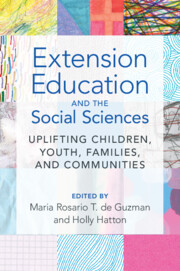Book contents
- Extension Education and the Social Sciences
- Extension Education and the Social Sciences
- Copyright page
- Contents
- Contributors
- Part I Overview of Extension and the Social Sciences
- Chapter 1 Introduction
- Chapter 2 Engaged Scholarship
- Chapter 3 Extension’s Role in Promoting Resilience among Rural Families with Low Incomes
- Chapter 4 Extension Programming to Enhance Urban Well-Being
- Part II Addressing Key Issues in the Well-Being of Children, Youth, and Families
- Part III Looking Ahead: Emerging Issues and Trends
- Index
- References
Chapter 1 - Introduction
The Role of Extension Education in Supporting Children, Youth, Families, and Communities
from Part I - Overview of Extension and the Social Sciences
Published online by Cambridge University Press: 28 March 2024
- Extension Education and the Social Sciences
- Extension Education and the Social Sciences
- Copyright page
- Contents
- Contributors
- Part I Overview of Extension and the Social Sciences
- Chapter 1 Introduction
- Chapter 2 Engaged Scholarship
- Chapter 3 Extension’s Role in Promoting Resilience among Rural Families with Low Incomes
- Chapter 4 Extension Programming to Enhance Urban Well-Being
- Part II Addressing Key Issues in the Well-Being of Children, Youth, and Families
- Part III Looking Ahead: Emerging Issues and Trends
- Index
- References
Summary
As the largest publicly funded, nonformal education system in the United States, Cooperative Extension (a.k.a. “Extension”) has played a critical role in how technologies and innovations generated through state agricultural experiment stations (AES) and land-grant universities (LGUs) in the United States have been translated and shared directly to its constituents for over a century. Extension has served as a unique and robust system to collaborate, generate, and disseminate research, as well as to engage in mission-oriented work to support communities in optimizing their current and future circumstances and through collaborative partnerships shaping the ways in which we cultivate and preserve food, how we educate and care for our children, manage our finances, work with communities, and support populations disproportionality affected by structural inequities. The current volume brings together leading scholars to discuss Extension’s contributions to the well-being of children, youth, families, and communities; and to critically reflect on Extension’s future directions in light of significant shifts in the context in which it now operates.
Keywords
- Type
- Chapter
- Information
- Extension Education and the Social SciencesUplifting Children, Youth, Families, and Communities, pp. 3 - 14Publisher: Cambridge University PressPrint publication year: 2024



